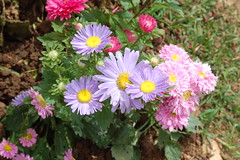Archive
Flowering Ornamental- Celosia
Good things about Celoisa
Celoisa is a flowering plant that is composed of Kimono and Pagoda series. Celoisa is an annual plant (new plants grow from seed each year) Celoisa Kimono
comes in cherry red, orange and scarlet. Considered dwarf and grow well under warm and sunny conditions. The Pagoda series which comes from gold, orange and red. Usually Pagoda series developed in pot culture.
To propagate Celoisa, start with the seeds indoors for 6-8 weeks. After that, you can plant it outdoor. Usually seeds germinate up to 10 days.
Good thing about celoisa is that it can be planted in containers for dwarf one. Celoisa produces large and brightly colored feathery flower heads that can be used in bouquets and dried flower arrangement.
Ornamental Plant-Zinnia
What is this Zinnia? Zinnias are member of Aster family of plants. It originated in Mexico and Southwest United States. Zinnia is compose of Bella series that consist of plants that are well branched that has a double flower and Profusion series that has a single flowers and usually dwarf. Bella series is composed of Bella ivory, Bella orange, Bella pink, Bella scarlet, Bella scarlet & yellow, Bella cherry& ivory and Bella cherry. Series of Profusion comes from cherry white and orange.
They are good to have ot in your garden since it is composed of different colors. They are also good to plant in container; it makes your garden wonderful and attractive. You can also use them as border plant.
Another good thing about zinnias is that they don’t need much attention since they can tolerate heat, humidity and drought. They also have a strong stems and staking is not necessary.
Bandera Espanola Plants:Uses|Impotance
Bandera Espanola( Canna indica) is the long genus of the family Cannaceae which is only comprised of 20 species from Central and South America. The name originated from the Greek name for a certain type of reed. Since the type species, C.indica, ca survive submerged in 6 inches of water, it behaves quite like the aquatic plant. However, it is not a native of India, but of the Wes Indies.
It is quite surprising that plant breeding of this tropical and subtropical genus was initiated and continuously done in temperate countries. The reason is more surprising because Cannas require a minimum of only six hours of a sunlight in order to grow in almost any type of soil. and seedlings will produce flowers in less than a year. Once they bloom, artificial pollination may be done again.
The Plants and their uses and Importance
Commonly known as Indian canna, Indian shot, edible canna, and arrowroot, the hard, round seeds of these plants are used by America Indians as bullets to kill their enemies. The Rhizomes are harvested for the flour that is why the plants are cultivated as a root crop just like the arrowroot or uraro( Maranta Arundinacea) but can also be eaten raw or cooked. In fact, for human consumption in the Andes, Vietnam , and Southern China where the starch is made into glass noodles or sotanghon.
The Plant is always bearing fruits and the seeds can be disseminated days after flower opening. The seeds can be used as material for jewelry and as a source of purple dye. these are also, used as moving elements of the kayamb, a musical instrument from Reunion, as well as the hosho, a gourd rattle from Zimbabwe. In India, the seeds are fermented to produce alcohol. Immature seeds are used as extender for tortillas. On the other hand, young shoots that contain at least 10 percent protein are harvested and cooked as vegetable, whole the fibers from leaves are made into paper. Even the rhizome has medicinal value. It is used as a diuretic when boiled and serves as as calmative in bladder spasms.





